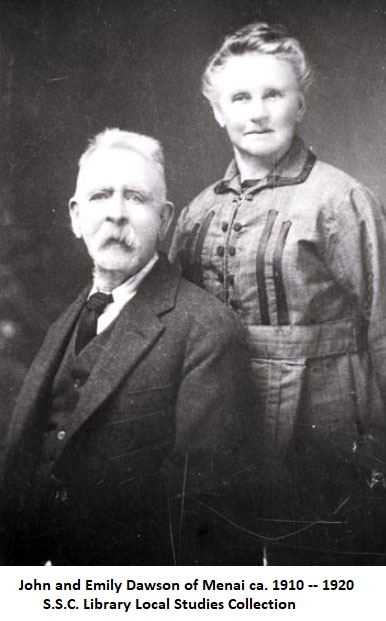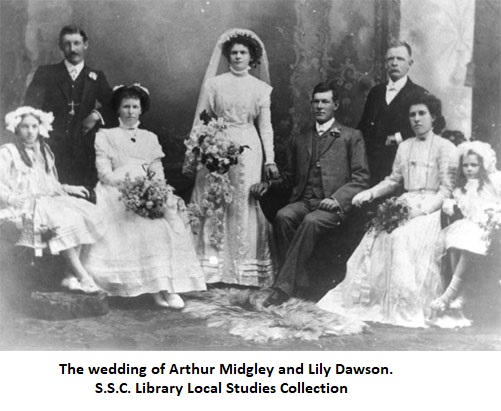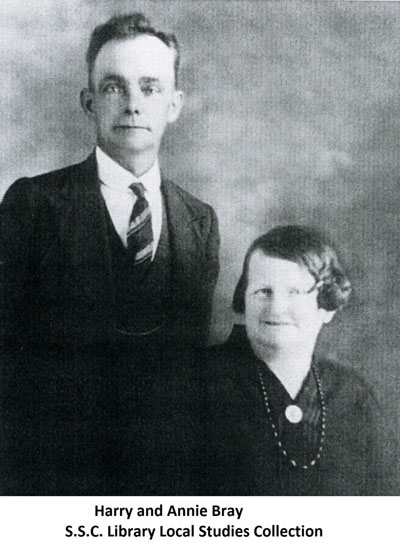

| Welcome | Database | Indexes | Copyright/Disclaimer | Login |
DAWSON and
BRAY FAMILIES
JOHN HENRY
ROBERTS (1851-1931) and EMILY DAWSON (1853- 1946)

John Henry Roberts Dawson,
the son of Henry Dawson and Martha Ann Roberts, was born on the 22 January 1851
at 139 Meadow Street, Sheffield England in the family home.
Emily Ward, the daughter of Alfred
Ward and Harriet Goodison, was born on the 4 December 1853 at Walkley, Nether
Hallam England (a Sheffield suburb).
John, aged 20 of Crescent Road, Walkley married Emily,
aged 17 of 189 King James Street, Walkley on 24 September 1871 at St Mary’s
Walkley. John’s occupation was given as file grinder and Emily was a dress
maker. Emily was unable to write her name. The witnesses were Alfred Ward and
Edward Harmston. A descendant of the couple, Fred Midgley, wrote in Emily’s
obituary, that after marriage they ran a ‘Mixed Business’ in Sheffield. However
I believe that this is unlikely because John was still listed as a file grinder
in 1877 and again in 1881. He gave his occupation as a ‘sheep shears grinder’ in
1884 on his immigration record. I believe it is unlikely that Emily would have
run a business as very few married women
worked in those days and she was illiterate when married. Their address in 1877
was 148 Greaves Street, Nether Hallam and in 1881 was 69 Walkley Bank Road,
Nether Hallam.
Their children, all born in the Sheffield area of
Yorkshire, were Emma born 1872, Annie born 28 August 1877, Edith born 1879,
Horace born 1882 and Lily born 1884. They also had another boy and a girl, both
of whom died in infancy before the family migrated to Australia.
Stories of fortunes to be made in Australia attracted
them and the family migrated in 1884 on the steam ship Abergeldie leaving from
Plymouth on 13 May and were landing in Sydney on 11 July 1884 .After arrival
they had intended to go to the ‘diggings’ but never left Sydney. In the first
year or so they lived at a variety of addresses, Botany, then Leichhardt, St
Peters and then in 1885 settled in Bellevue Parade, Hurstville, in those days
sparsely populated, while John followed his trade of grinder (ie cutler).
After 12 years at Hurstville they took up a ‘Homestead
Selection’ of 23 acres (Portion 258) in Menai Road, Menai (previously known as
Bridge Road), some time between 1897 and 1899, there being very few other
families living in that area then. However, they were still actually living in
Bellevue Parade, Hurstville on 22 April 1898 (when their daughter Annie married
Harry David Bray), but must have moved onto their land very soon afterwards. The
Old Illawarra Road, connected by a small hand-operated punt over the Georges
River at Lugarno was the only access to the city. They ran a mixed farm, mainly
poultry on the property, his occupation being given as farmer in 1930.
Emily Dawson was involved in many pioneer works at
Menai, chiefly being the foundation of the School of Arts and the Congregational
Church. Their land, portion 258 Menai Road, was originally taken up in 1897/99
and their right to it was confirmed on the 4 June 1912. It was eventually
purchased in Emily’s name on 23 June 1931 just after John died, for £34/2/6. You
can find the location of their house on current street directories, as there is
a street named after them called Dawson Place on what was their land, right
beside the shops called Menai Market Place. I have been told that their house
stood for many years and was kept by the Council and historical societies as an
example of pioneer housing. Unfortunately it was demolished after being badly
vandalised. Sadly I never went to see it, as I was not aware of its existence
until after it had gone. After Emily’s death the land passed to her children
Horace and Lily.
All
their surviving children married, Emma married John Grogan in 1911 at
Hurstville, Annie married Harry David Bray on the 22 April 1898 at Kogarah,
Edith married Frederick Browne in 1902 at Hurstville, Horace married Emily
Fisher in 1909 in Sydney and Lily married Arthur Midgley in 1909 in the
Sutherland area, probably Menai. Arthur and Lily Midgley settled in Menai and
raised a family there.

John, aged 80, died on the 6 June 1931 at the home of
his son Horace at 77 Beaconsfield Street, Bexley. John’s occupation was given as
farmer. He was buried on the 8 June 1931 in the Church of England section
Woronora Cemetery, (section AF grave 252). After John’s death Emily went to live
with family in the St George district. She later returned to her own home at
Menai in January 1945. She was an expert needlewoman and possessed a fine
memory. Emily died on the 8 July 1946, aged 92, at her home in Menai Road Menai.
She was buried on the 10 July 1946 in the Church of England section Woronora,
(section AF, grave 252).
Click on the names
JOHN HENRY ROBERTS (1851 – 1931) and EMILY DAWSON (1853
-1946) in the heading of this story. You will be taken to the database
entry for John Henry Roberts and his family.
HARRY DAVID (1877- 1941) and ANNIE (1877-1952) BRAY
 Homestead
Selectors of Menai
Homestead
Selectors of Menai
Harry David Bray,
the son of Harry Cornelius Bray and Mary Bannatyne Armitage, was born on the 2
August 1877 at Wyndham Street, Alexandria NSW in the family home.
Annie Dawson, the daughter of John
Henry Roberts Dawson and Emily Ward was born on 28 August 1877 at 148 Greaves
Street, Nether Hallam, Sheffield Yorkshire, in the family home. Annie and family
migrated to Australia on 11 July 1884 in the ship Abergeldie.
Harry, aged 20 of Woids Avenue Hurstville and Annie,
aged 20 of Bellevue Parade Hurstville, were married on the 22 April 1898 at ‘The
Laurels’, Webbers Road Kogarah. The witnesses were Harry Cornelius Bray and
Edith Dawson. Harry David’s occupation then was given as mattress maker and
Annie’s was machinist.
Their children were, Horace Cornelius born 2 November
1899 in Hurstville, Florence Emily born 5 August 1901 in Hurstville, Harry David
born 3 June 1903 in Hurstville, Jack Cyril born 30 October 1904 in Hurstville,
Thelma Emma born 9 March 1909 in Sydney, Frank Hamilton born 16 January 1912 in
Menai and Daphne Dawson born 25 July 1917 in Arncliffe.
By
mid June 1903 the family were residing in Menai and had taken up a Homestead
Selection of 24 acres, (Portion 298, Old Illawarra Road), just as Annie’s
parents had done. I think it could be possible that they went to Menai about the
same time as her parents, however the first four children’s births were
registered at Hurstville, the last being Jack Cyril on 30 October 1904. This
would be a sensible precaution as not many people were in Menai at that time.
Frank was the only child born in their house in Old Illawarra Road Menai, the
remainder being born in Sydney. The location of this house can easily be located
on a current street map, as it would have stood about the middle of what is now
the Blaxland Drive Reserve. The Menai High School now stands over part of this
land and the corner of Blaxland Drive and Morton Road is almost exactly at the
middle of it.
When taken up, this land was natural bush and Harry
began to clear it while still working in Sydney. Can you imagine commuting to
and from the city in those days with the lack of transport? He eventually was
able to make a living from the land running a poultry farm and market garden.
The confirmation of the right to this land was granted on 22 July 1920 and was
then purchased for the sum of £36.5.8 which in those days was a very much larger
sum than it sounds today. It was finally paid for on 15 May 1941 sadly not long
before Harry died. His occupation was given as gardener in 1936 and farmer when
he died in 1941.
All of their
children married. Horace married Nellie Embleton on 11 February 1930, Florence
married Herbert Dine on 1 June 1929, and Harry married Dulcie Thompson on 12
January 1929. Jack married Esme Croft on 14 December 1927, Thelma married Albert
Long on 2 July 1929, Frank married Edna Embleton on 18 August 1936 and Daphne
married Charles Bertram on 24 September 1938. Nellie and Edna Embleton are
sisters.
Harry
died aged 64 of cerebral thrombosis on 25 September 1941 at Lidcombe State
Hospital. His usual residence at that time was Old Illawarra Road Menai and
occupation was given as poultry farmer. He was buried on 26 September 1941 in
the Church of England section Woronora Cemetery, section AF, grave 573.
Annie died, aged 74 on 20 June 1952 in her home in Old
Illawarra Road Menai of coronary occlusion. She was buried in the Church of
England portion of Woronora Cemetery on 23 June 1952, section AF, grave 573.
THE LAND
Both parcels of land occupied by John and Emily Dawson
and Harry and Annie Bray were taken up by conversion of a ‘Homestead Selection’.
This was Crown land that had been originally ‘selected’ by a person, which then
gave them the right to occupy, use and ‘improve’ it. Then as a result of the
Crown Lands Consolidation Act of 1913, those who qualified were finally able to
purchase the land they were occupying directly from the Government.
An original release of 10 lots for selection was made in
December 1896 which became the village of Menai. The land ‘selected’ by John and
Emily Dawson was portion 258 and was one of these original lots. It is known
that John and Emily Dawson were living on their land in Menai, sometime around
1898/1899 and there probably was no more than 11 other families living in that
area the time. The title deed shows that they had met the conditions in 1912 but
the land was actually purchased by Emily Dawson after the death of her husband
John in 1931.
When Harry and Annie Bray were married in 1898 they were
both living in Bellevue Parade, Hurstville. They also took up land at Menai,
portion 298 Old Illawarra Road,
sometime well before 1909, possibly by 1903, as they were living in Menai by mid
June 1903. This was a later release of land, date unknown though sometime after
the original 10 lots. It probably would have been soon after her parents moved
there, as it would seem likely to me that they would do it together for mutual
support. The title deed shows they qualified for the land in 1920 but it was not
purchased until 1940. The title deed also shows that when the land was finally
paid for in 1941 parts of the land were sold or given to their sons Harry Jnr
and Jack. Both of them had built their houses and were living there with their
families at that time. By then Mick (Horace) had his own land and house next
door and Frank was living in Campsie with his family. Daphne married Charles
Bertram in 1938 and after Harry then Annie died, Daphne and Charles lived in the
old house for a number of years before it was finally sold out of the family.
Mick
(Horace) Bray took up his block, portion 387 Old Illawarra Road, next to Harry
and Annie’s, as a Homestead Selection, he qualified in 1921 and finally
purchased it in 1943. The order of the houses on the left as you came up Old
Illawarra Road from the ferry was Mick and Nellie’s, Harry and Dulcie’s, Jack
and Esme’s then the old house of Harry and Annie. A family of cousins, the
Berry’s lived on the right hand side of the road in the same area.
Why did they go way out there? When they went there, it
really was miles from anywhere and was still virtually untouched natural bush,
there were no facilities at all and hardly any people. A small hand operated
ferry crossed the river at Lugarno to get to Hurstville and there was a bridge
of some sort at Woronora, which meant you could also get across to Sutherland as
well. The road, (Old Illawarra Road), meandered through the bush down to Bulli
Pass, as this road was the early way down to the coast. It was not even
particularly good land, most of it rocky and covered with stunted scrub, with
just a small fertile bit down where they had the market gardens.
My
guess is that the desire to own land was overwhelmingly strong, particularly for
‘working class’ English like the Dawsons who would never have even dreamt of the
possibility of owning property back in England. Yet here was the opportunity of
owning land for a reasonable price and a lot of very hard work and obviously
they went for it despite all the hardships that it meant. How did they get to
hear of the land? Did they ‘select’ it sight unseen off a map or did they
actually go out there by horse and cart to see it first? There had been articles
about the land in the St George Advocate and this obviously sparked their
interest and led to them taking up the land.
During
the family‘s early life on the land at Menai, they had no electricity or running
water of course and the district was very sparsely settled with the nearest
supplies quite a distance away. The produce from the market garden was taken to
Sydney Markets by horse and cart. The children first went to school at Menai,
then at Sutherland and had to walk there across country a distance of about 7
miles. The families were ‘pioneers’ in the true sense of the word.
A contemporary report in the St George Advocate dated 1
March 1902 gives a description of the area as follows:
In fulfilment of a long
standing promise, I paid a visit to Bangor recently, where some of our Miranda
friends Webbs, Midgleys, Bentleys and Maymans) have been living for the past
five years. As readers of this column have heard much of Bangor – formerly known
as Holdsworthy – a description of the place and how the people are situated will
be interesting. This settlement consists of ten blocks. It was thrown open for
selection in December, 1896, and is about a mile square. Its southern boundary
is the southern boundary of the Sydney metropolitan area. It sits regally
astride a sandstone ridge which runs due north and south about three miles west
of Sutherland and eight miles from Hurstville. The main road traverses this
ridge the land falling by easy slopes eastward and westward. There are
magnificent gullies where an unlimited water supply could be saved.
The material for
constructing the dams can be got from plentiful outcropping of sandstone rock.
Useful timber of iron bark, stringy, mahogany, bloodwood, gum and oak is
abundant. The top soil is a loamy sand with a friable red clay subsoil easy to
work. It is a soil well suited for orchard and garden purposes and could be
raised to a high degree of scientific farming. It will respond generously to
green manuring.
There are two blocks of
seventeen acres, the others average twenty eight. The selection has been made
under Mr. Carruthers Act of 1895 [Minister for Lands]. The blocks are valued at
30/- and £1. Curiously, the land selected by most experienced and successful
gardeners is valued at the lower figure. The annual rental is fixed at
threepence in the pound for the first five years.
Alfred Midgley included the above newspaper article in
his book Reflections Menai Congregational Church 1901-1977 and added:
Those who came from
Miranda, for example, saw an escape from the Landlord and tenant farming under
the Holt landowning system. They accepted the challenge of ‘fresh field and
pastures new’ and advanced with the pioneer spirit so much evidenced in
Australian history of past generations. This pioneer spirit strove against
droughts and adversities in carving out a livelihood in the virgin bush. It
triumphed with fortitude in good seasons and bad; in the sickness and;
misfortune and death; steadfast in a faith that stems from God – a faith that
gives courage and strength not only to the physical being, but primarily to
man’s deepest need, the spiritual. This faith gave root to a common unity in
gathering together the handful of pioneer settlers to link their hearts in the
worship of their Creator, Almighty God.
This newspaper reporter’s description of the land seems
hopelessly optimistic to me considering the quality of the land before the homes
were built there.
NEVILLE BRAY
First published in Sutherland Shire, Some Early Residents, 2006, by Botany Bay Family History Society. Compiled by Maree McKinley and Sue Hewitt.
Click on the names
HARRY DAVID (1877 – 1941) and ANNIE (1877 – 1952) BRAY
in the heading of their story. You
will be taken to the database entry for Harry David Bray and his family.